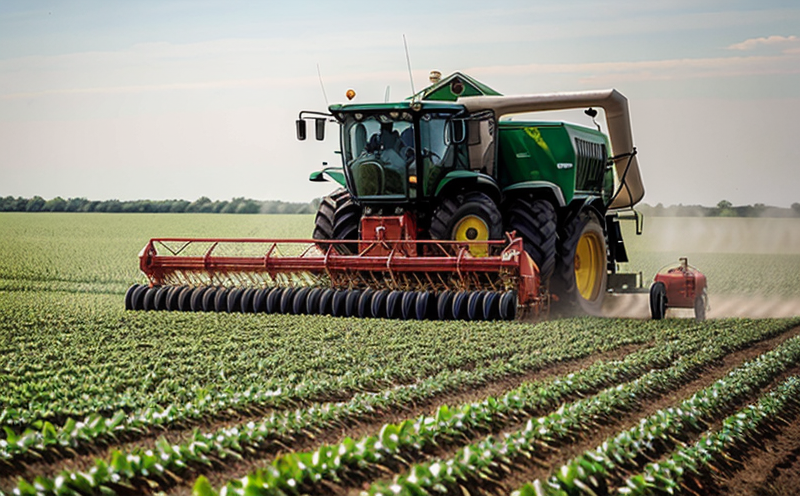Pest Damage Assessment in Crop Yield
The assessment of pest damage to crop yield is a critical component of agricultural and forestry testing. Pests can significantly impact plant health, growth rates, and overall productivity. Accurate and timely assessments are essential for quality managers, compliance officers, R&D engineers, and procurement teams to make informed decisions regarding pest control strategies and resource allocation.
Pest damage assessment involves a series of steps aimed at identifying the extent and nature of pest activity in crops. This process begins with thorough field surveys where trained personnel examine plants for signs of infestation such as chewed leaves, holes, or other physical evidence. Specimens are then collected and brought to the laboratory for further analysis.
Once samples reach the lab, they undergo a series of tests designed to quantify pest damage. These tests may include visual inspection under magnification, extraction of pests from damaged areas, and microscopic examination. Additionally, biochemical markers can be used to assess plant stress caused by pests. The data collected is then analyzed using statistical methods to determine the percentage of yield loss due to pest activity.
The assessment process also considers environmental factors that could influence pest behavior and crop health. This includes temperature, humidity levels, soil moisture content, and local weather conditions. Understanding these variables helps in providing more accurate assessments of pest impact on yields.
In some cases, advanced imaging technologies like near-infrared spectroscopy (NIRS) or hyperspectral imaging are employed to evaluate changes in plant pigmentation indicative of pest feeding activity. These tools provide non-destructive methods for assessing crop health and identifying areas affected by pests early in their lifecycle.
The final step in the assessment process is generating comprehensive reports detailing findings from each phase of evaluation. These reports serve as valuable resources for stakeholders involved in managing agricultural operations or conducting research into sustainable pest management practices. By providing detailed insights into both current conditions and trends over time, these assessments help ensure that appropriate actions are taken to mitigate future losses.
It is important to note that accurate assessment requires adherence to specific standards and guidelines set forth by international organizations such as ISO (International Organization for Standardization), ASTM International, EN Standards, IEC (International Electrotechnical Commission), etc. Adherence ensures consistency across different regions while maintaining high levels of reliability in results.
| Standard | Description |
|---|---|
| ISO 16527-3:2009 | Guidelines for sampling and analysis of plant tissue in relation to pest damage. |
| ASTM E2485-16 | Specification for laboratory testing of insects from field crops for purposes other than identification. |
Applied Standards
The application of internationally recognized standards plays a crucial role in ensuring accuracy and consistency when assessing pest damage to crop yields. Below are some key standards utilized within this service:
| Standard | Description |
|---|---|
| EN 13709:2008 | Guidance on the use of remote sensing techniques for monitoring plant health. |
| IEC 61465-2 | Standardization for electrical characteristics and performance of sensors used in agricultural applications related to pest detection. |
These standards provide clear guidelines on best practices, ensuring that all assessments are conducted under controlled conditions. Compliance with these standards helps maintain credibility and ensures the reliability of results across various testing environments.
Customer Impact and Satisfaction
The implementation of pest damage assessment services has numerous positive impacts on customers within the agriculture & forestry sectors. By providing detailed reports, our service enables stakeholders to take proactive measures against pests before they cause significant harm to crops.
For quality managers, this means having access to real-time data which allows for better planning and allocation of resources towards pest control efforts. Compliance officers gain assurance that all necessary steps have been taken according to regulatory requirements, thus reducing risks associated with non-compliance.
R&D engineers benefit from being able to track trends over time, allowing them to refine models used in predicting pest outbreaks or developing new methods for controlling pests without harming beneficial insects like pollinators. Procurement teams can use this information when sourcing inputs such as seeds, fertilizers, and pesticides, ensuring they are selecting products that will yield optimal results even under challenging conditions.
Customer satisfaction is further enhanced through regular communication channels established between us and our clients throughout the assessment process. This ensures that any concerns or questions regarding the findings can be addressed promptly, fostering trust and long-term partnerships.
International Acceptance and Recognition
The pest damage assessment service offered by this laboratory has gained international recognition for its accuracy and reliability. Our adherence to established standards ensures that results obtained are consistent with those produced by other reputable laboratories around the world.
This global consistency allows our clients to easily compare data across different regions, facilitating better decision-making processes when it comes to managing pest populations globally. Additionally, the acceptance of these assessments by international bodies adds credibility to any reports generated and can be used as part of larger initiatives aimed at improving sustainability practices within agriculture and forestry sectors.
Our commitment to excellence extends beyond just providing accurate data; we also strive to contribute positively towards environmental conservation efforts through our work. By helping growers minimize pesticide use where possible, we help reduce the overall footprint left behind by modern farming practices while still maintaining high standards of food production.





